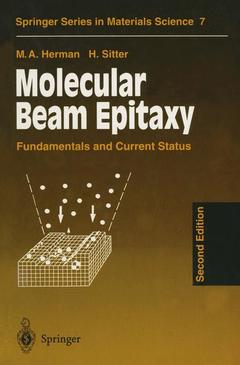Description
Molecular Beam Epitaxy (2nd Ed., 2nd ed. 1996. Softcover reprint of the original 2nd ed. 1996)
Fundamentals and Current Status
Springer Series in Materials Science Series, Vol. 7
Authors: Herman Marian A., Sitter Helmut
Language: English
Subjects for Molecular Beam Epitaxy:
Keywords
chemistry; epitaxy; film; material; production; quantum dot; semiconductor; semiconductor devices
89.66 €
In Print (Delivery period: 15 days).
Add to cart
Publication date: 10-2013
453 p. · 15.5x23.5 cm · Paperback
453 p. · 15.5x23.5 cm · Paperback
Description
/li>Contents
/li>Comment
/li>
Molecular Beam Epitaxy describes a technique in wide-spread use for the production of high-quality semiconductor devices. It discusses the most important aspects of the MBE apparatus, the physics and chemistry of the crystallization of various materials and device structures, and the characterization methods that relate the structural parameters of the grown (or growing) film or structure to the technologically relevant procedure. In this second edition two new fields have been added: crystallization of as-grown low-dimensional heterostructures, mainly quantum wires and quantum dots, and in-growth control of the MBE crystallization process of strained-layer structures. Out-of-date material has been removed.
Background Information.- 1. Introduction.- Technological Equipment.- 2. Sources of Atomic and Molecular Beams.- 3. High-Vacuum Growth and Processing Systems.- Characterization Methods.- 4. Characterization Techniques.- MBE Growth Process.- 5. MBE Growth Processes of Lattice-Matched Structures.- 6. Growth Processes in Strained-Layer MBE.- 7. Material-Related Growth Characteristics in MBE.- Conclusion.- 8. Outlook.- References.
This book describes a technique in wide-spread use for the production of high-quality semiconductor devices. It discusses the most important aspects of the MBE apparatus, the physics and chemistry of the crystallization of various materials and device structures, and the characterization methods that relate the structural parameters of the grown (or growing) film or structure to the technologically relevant procedure. In this second edition two new fields have been added : crystallization of as-grown low-dimensional heterostructures, mainly quantum wires and quantum dots, and in-growth control of the MBE crystallization process of strained-layer structures.
© 2024 LAVOISIER S.A.S.




